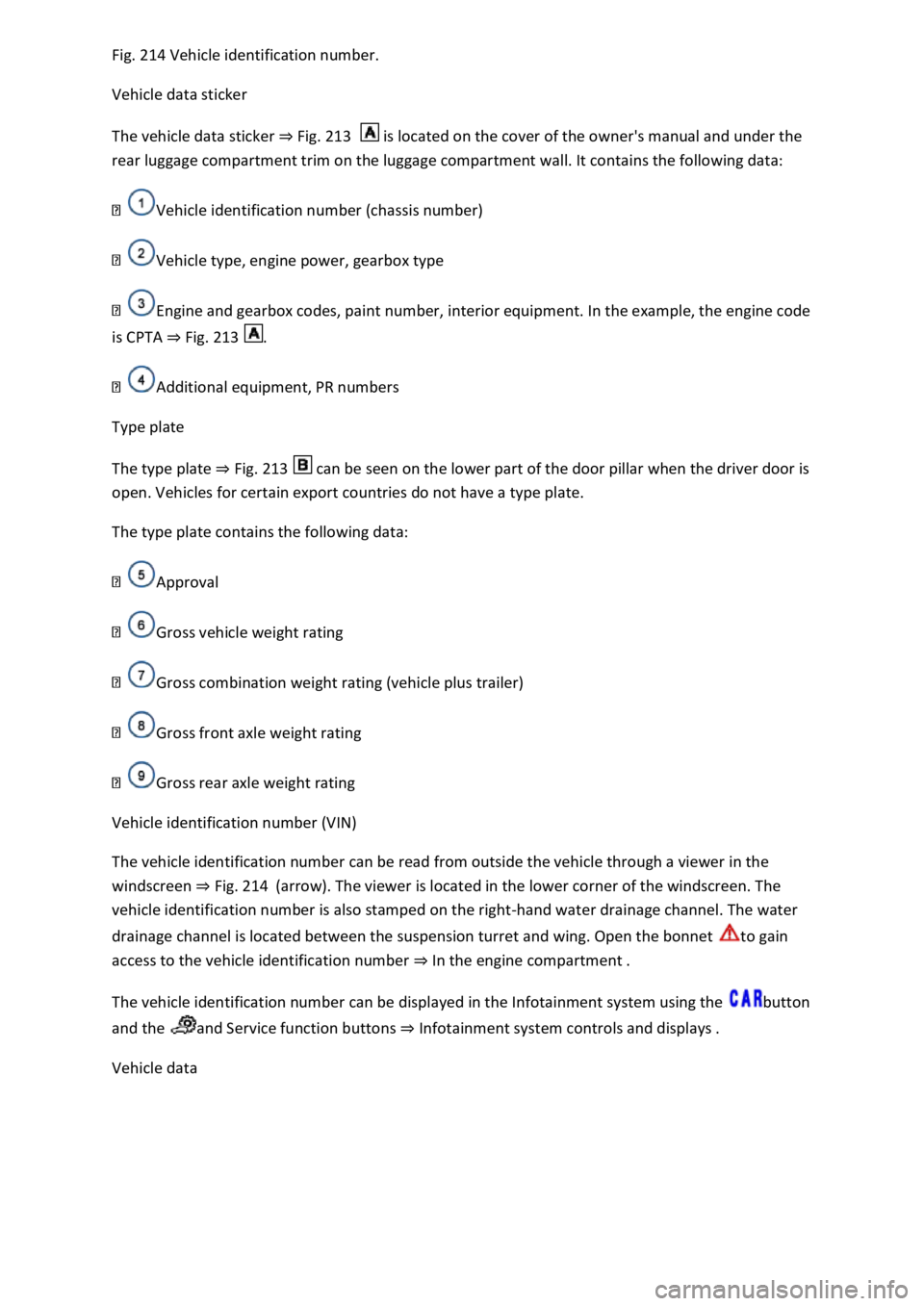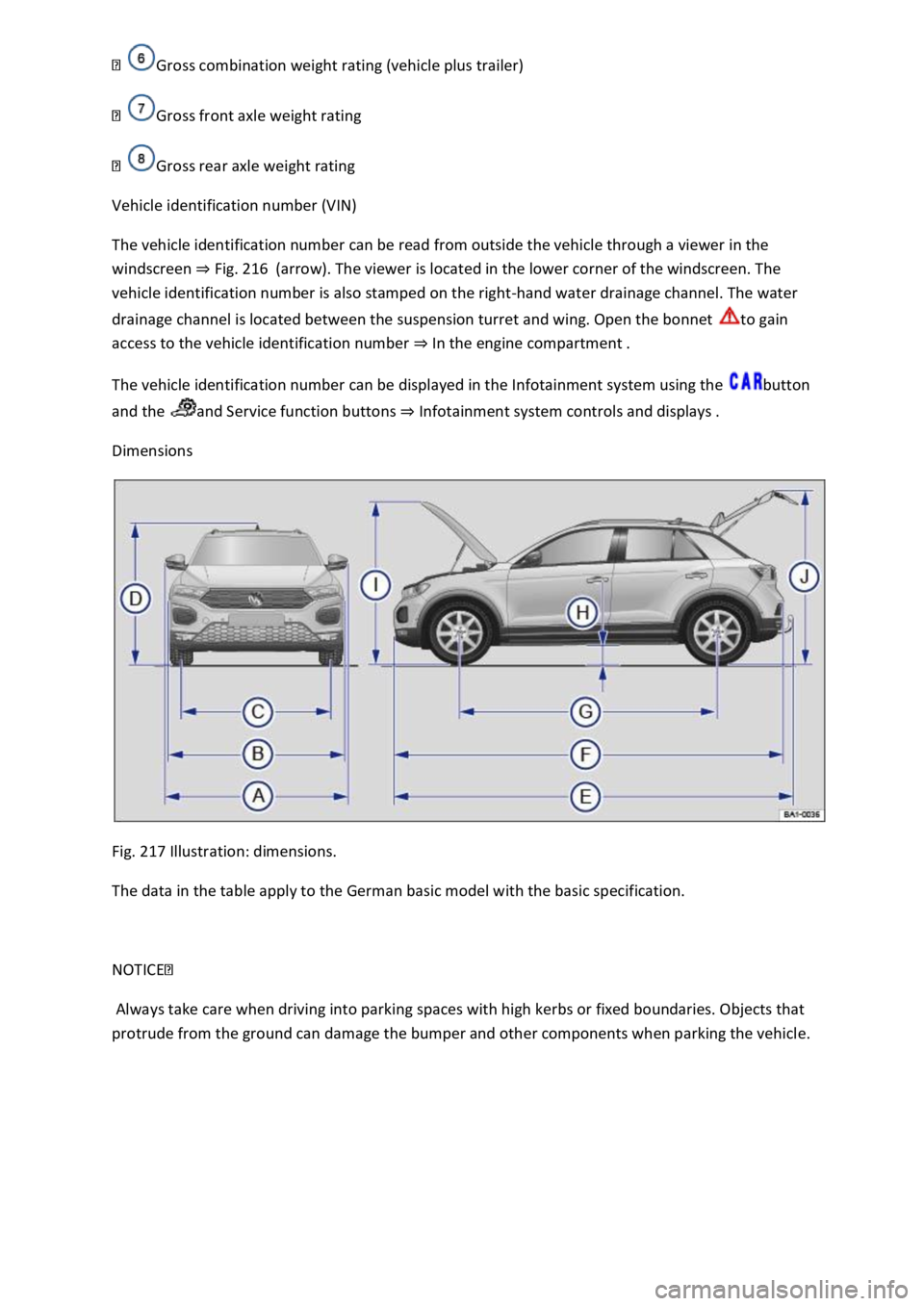Page 319 of 502
prior to downhill gradients (manual gearbox or Tiptronic mode of the
automatic gearbox) to additionally make use of engine braking. The brake system could otherwise
overheat and fail.
will change because of the
trailer load and the increased combined towing weight of the vehicle and trailer.
When driving with this combination, drive particularly carefully and slowly.
Pulling off on slopes when towing a trailer
Depending on the steepness of the uphill gradient and the total weight of the trailer and vehicle, a
vehicle towing a trailer could roll back a short distance when moving off on a hill.
When towing a trailer, pull off on slopes as follows:
once to switch off the electronic parking brake Electronic parking brake
ly.
Manual gearbox: selecting a gearor selector lever position D/SDSG
Page 459 of 502

vehicle production, with the basic requirements and other relevant laws and regulations, including
FCC Part 15.19, FCC Part 15.21 and RSS-Gen Issue 1:
Radio-based equipment
luding City Emergency Braking System.
Electrical equipment
-volt socket.
Recycling and scrapping end-of-life vehicles
Recycling end-of-life vehicles
Volkswagen has already made provision for you to recycle your vehicle in an environmentally
responsible manner. The extensive recycling systems operating in many European countries will take
back your vehicle at the end of its useful life. Once the vehicle has been recycled, a certificate of
destruction will be issued to show that the vehicle has been disposed of correctly.
Return of end-of-life vehicles is free of charge, provided that national legislation is complied with.
Further information on return and recycling of end-of-life vehicles is available from a Volkswagen
dealership.
Scrapping
The relevant safety requirements must be observed when the vehicle or its individual components,
e.g. from the airbag system and belt tensioners, are scrapped. Qualified workshops are familiar with
these regulations.
Information about vehicles with N1 approval (light commercial vehicle)
Please observe the following for vehicles used to transport goods with a maximum permitted weight
of up to 3.5 t (N1 approval in Europe):
Variants and number of seats
There are various types of N1 vehicles based on a Volkswagen passenger car. The number of seats
may be restricted to two or four.
Page 460 of 502

ering in the rear of the vehicle interior because there is
no rear bench seat
Vehicles with four seats: the centre seat on the rear bench seat cannot be used
Transporting children safely
As with vehicles with passenger car approval (M1), approved child restraint systems can be used on
the seats Safe transport of children
Towing a trailer
If the vehicle is approved for towing a trailer, observe any local regulations for driving with a trailer
and using a towing bracket.
If the vehicle exceeds the gross vehicle weight rating or the rear axle load, do not exceed 80 km/h
when towing a trailer. This also applies to countries where higher speeds are permitted. Keep to
country-specific speed limits which may be lower for vehicles with trailers than for vehicles without
trailers.
The vehicle documents contain details of permitted excess loads. If no excess loads are shown, the
vehicle can be driven at 100 km/h, taking account of the laws which apply in different countries.
Technical data
Please refer to the vehicle documentation for technical data.
WARNING
Risk of injury and electric shock from exposed cables.
vehicle are covered up when using the vehicle.
WARNING
Risk of serious injuries due to transporting passengers incorrectly.
ms such as seat
belts and head restraints.
WARNING
Risk of serious and fatal injuries.
Page 486 of 502

restricted, not possible, or possible only when additional requirements have been fulfilled.
Technical data
Notes on technical data
Unless otherwise indicated or separately listed, the technical data apply to the basic model. The
values may differ if additional equipment is fitted, for different model versions and for special
vehicles and in the case of country-specific vehicle specifications. All data in the official vehicle
documents take precedence over these data.
Engine
The vehicle data sticker and the official vehicle documents show which engine is installed in your
vehicle.
Weight
The values for the kerb weight in the following tables apply for the road-ready vehicle with driver
(75 kg), service fluids including fuel tank carrying 90% of its capacity and, where applicable, tools and
spare tyre ed accessories increase the stated kerb weight
and reduce the maximum permitted load accordingly.
The load comprises the weights of the following:
system
Performance figures
In certain vehicles with heavy duty running gear, the engine could be governed to provide a
maximum speed of 210 km/h.
The performance figures were measured without equipment which may negatively influence
performance, such as a roof carrier or mudflaps.
Gross combination weight
The specified gross combination weights are applicable only for altitudes up to 1,000 m above sea
level. The maximum gross combination weight must be reduced by approximately 10% for every
further started 1,000 m in altitude.
Notes on the tables
Gearbox abbreviations: MG = manual gearbox, AG = automatic gearbox, DSG
Page 487 of 502
weights, payload, dimensions, vehicle speeds and axle weight
ratings could cause damage to the vehicle, accidents and serious injuries.
maximum speeds.
axle loads must never exceed the gross axle weight ratings.
braking distance of the vehicle. Adjust your speed accordingly.
NOTICE
The load should be distributed as evenly as possible in the vehicle. When transporting heavy objects
in the luggage compartment, they should be placed either in front of or over the rear axle in order to
minimise the effect on the vehicle's handling.
NOTICE
Observe the instructions and information for vehicles with an N1 approval Information about
vehicles wit
Vehicle data
Fig. 213
Page 488 of 502

214 Vehicle identification number.
Vehicle data sticker
The vehicle data sticker Fig. 213 is located on the cover of the owner's manual and under the
rear luggage compartment trim on the luggage compartment wall. It contains the following data:
Vehicle identification number (chassis number)
Vehicle type, engine power, gearbox type
Engine and gearbox codes, paint number, interior equipment. In the example, the engine code
is CPTA Fig. 213
Additional equipment, PR numbers
Type plate
The type plate Fig. 213can be seen on the lower part of the door pillar when the driver door is
open. Vehicles for certain export countries do not have a type plate.
The type plate contains the following data:
Approval
Gross vehicle weight rating
Gross combination weight rating (vehicle plus trailer)
Gross front axle weight rating
Gross rear axle weight rating
Vehicle identification number (VIN)
The vehicle identification number can be read from outside the vehicle through a viewer in the
windscreen Fig. 214(arrow). The viewer is located in the lower corner of the windscreen. The
vehicle identification number is also stamped on the right-hand water drainage channel. The water
drainage channel is located between the suspension turret and wing. Open the bonnet to gain
access to the vehicle identification number In the engine compartment
The vehicle identification number can be displayed in the Infotainment system using the button
and the and Service function buttons Infotainment system controls and displays
Vehicle data
Page 489 of 502
Fig. 215
Fig. 216 Vehicle identification number.
Vehicle data sticker
The vehicle data sticker Fig. 215 is located on the cover of the owner's manual and under the
rear luggage compartment trim on the luggage compartment wall. It contains the following data:
Vehicle identification number (chassis number)
Vehicle type, engine power, gearbox type
Engine and gearbox codes, paint number, interior equipment. In the example, the engine code
is CCZB Fig. 215
Additional equipment, PR numbers
Type plate
The type plate Fig. 215can be seen on the lower part of the door pillar when the driver door is
open. Vehicles for certain export countries do not have a type plate.
The type plate contains the following data:
Gross vehicle weight rating
Page 490 of 502

Gross front axle weight rating
Gross rear axle weight rating
Vehicle identification number (VIN)
The vehicle identification number can be read from outside the vehicle through a viewer in the
windscreen Fig. 216(arrow). The viewer is located in the lower corner of the windscreen. The
vehicle identification number is also stamped on the right-hand water drainage channel. The water
drainage channel is located between the suspension turret and wing. Open the bonnet to gain
access to the vehicle identification number In the engine compartment
The vehicle identification number can be displayed in the Infotainment system using the button
and the and Service function buttons Infotainment system controls and displays
Dimensions
Fig. 217 Illustration: dimensions.
The data in the table apply to the German basic model with the basic specification.
NOTICE
Always take care when driving into parking spaces with high kerbs or fixed boundaries. Objects that
protrude from the ground can damage the bumper and other components when parking the vehicle.